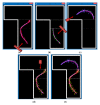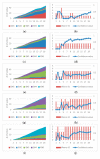Appearance-based multimodal human tracking and identification for healthcare in the digital home
- PMID: 25098207
- PMCID: PMC4179041
- DOI: 10.3390/s140814253
Appearance-based multimodal human tracking and identification for healthcare in the digital home
Abstract
There is an urgent need for intelligent home surveillance systems to provide home security, monitor health conditions, and detect emergencies of family members. One of the fundamental problems to realize the power of these intelligent services is how to detect, track, and identify people at home. Compared to RFID tags that need to be worn all the time, vision-based sensors provide a natural and nonintrusive solution. Observing that body appearance and body build, as well as face, provide valuable cues for human identification, we model and record multi-view faces, full-body colors and shapes of family members in an appearance database by using two Kinects located at a home's entrance. Then the Kinects and another set of color cameras installed in other parts of the house are used to detect, track, and identify people by matching the captured color images with the registered templates in the appearance database. People are detected and tracked by multisensor fusion (Kinects and color cameras) using a Kalman filter that can handle duplicate or partial measurements. People are identified by multimodal fusion (face, body appearance, and silhouette) using a track-based majority voting. Moreover, the appearance-based human detection, tracking, and identification modules can cooperate seamlessly and benefit from each other. Experimental results show the effectiveness of the human tracking across multiple sensors and human identification considering the information of multi-view faces, full-body clothes, and silhouettes. The proposed home surveillance system can be applied to domestic applications in digital home security and intelligent healthcare.
Figures











References
-
- Microsoft Corp. Kinect for Xbox 360 [(accessed on 30 May 2013)]. Available online: http://www.xbox.com/en-GB/kinect.
-
- Rice A., Phillips P., Natu V., An X., O'Toole A. Unaware Person Recognition from the Body When Face Identification Fails. Psychol. Sci. 2013;24:2235–2243. - PubMed
-
- Sixsmith A., Johnson N. A smart sensor to detect the falls of the elderly. IEEE Pervasive Comput. 2004;3:42–47.
-
- Ni B., Dat N., Moulin P. RGBD-Camera Based Get-up Event Detection for Hospital Fall Prevention. Proceedings of International Conference on Acoustics, Speech and Signal Processing; Kyoto, Japan. 25–30 March 2012; pp. 1405–1408.
Publication types
MeSH terms
LinkOut - more resources
Full Text Sources
Other Literature Sources
Medical

